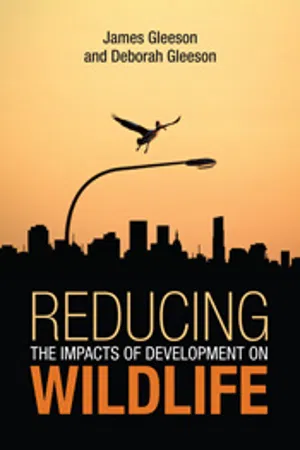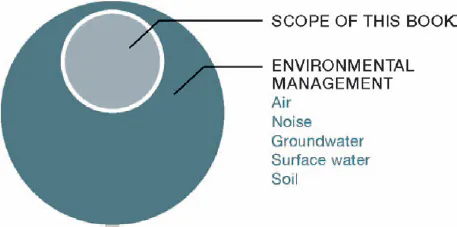![]()
1
Introduction
Why this book was written
It seems that everywhere you look in Australia right now there is some sort of development going on. Like many countries around the world, cities and towns are ever stretching across once natural landscapes, transport networks are spreading and natural resources are being consumed faster than ever. The high rate of development in Australia is partly fuelled by its thriving resources sector servicing unprecedented overseas demand for minerals (particularly coal and iron ore). New mines are springing up, established mines are expanding and rail and port infrastructure is being built to overcome transport bottlenecks. At the same time, sharp population increases have taken place. A staggering 421 300 people were added to Australia’s population in 2009 alone, with the population predicted to possibly almost double to 42.5 million by 2056 (Australian Bureau of Statistics 2008; Australian Bureau of Statistics 2011a). In recent years, Australia has had the fastest-growing population in the developed world, easily outpacing the growth rates of China and India (Smith 2011). More people results in a need for more residential and commercial developments, as well as supporting infrastructure such as powerlines, roads, pipelines and bridges.
Developments are, by and large, encouraged by governments around the world because they bring affluence to a country in the form of jobs and a stronger economy. However, more development places greater pressure on the natural environment. Some developments have a greater impact on the environment than others, depending on their location and size as well as how they are designed and managed. The consequences of poor planning of development may include permanent loss or degradation of important flora and fauna habitat, disruption of dispersal pathways and extinction of species.
In the pursuit of preventing adverse impacts on the environment, there is a push for development to be ‘sustainable’, in preference to curbing growth or the factors driving it. ‘Ecologically sustainable development’ is a policy concept that involves undertaking development to meet human needs in such a way as to conserve and/or enhance natural ecosystems (Ecologically Sustainable Development Steering Committee 1992; Hezri and Dovers 2009).
Overall, biodiversity continues to substantially decline in many parts of Australia (Beeton et al. 2006). Now, more than ever, it is crucial that we ensure that developments are undertaken in a manner that reduces impacts on the environment and that the phrase ‘ecologically sustainable development’ is not just used as a trendy catchcry to justify development. In particular, reducing impacts of development on native wildlife (plants and animals) is essential for the maintenance of biodiversity and preservation of functioning ecosystems.
There is reason for hope and optimism because measures to reduce impacts of development on flora and fauna are increasingly being incorporated into developments in Australia and many other parts of the world. Practical measures must be correctly selected, designed and implemented not only to ensure the best outcome for wildlife but also to avoid unnecessary costs to enable the development to run productively. Development and conservation are not necessarily mutually exclusive. Rather, both can be achieved where there is genuine commitment to conservation.
So, how effective are the measures currently used to reduce the impacts of development on wildlife? In recent years, many of these measures have been adopted as industry standards without rigorous scientific testing to validate them. Other measures have been tested, but the results of this testing often remain hidden in scientific journals that are not readily accessible to the general public, instead of influencing how these measures are applied. If a development relies upon a particular measure to reduce impacts on wildlife, the design, effectiveness and reliability of that measure must be well established: otherwise it risks failing. In some situations, incorrect application of a measure can also be damaging to the environment. These problems make it difficult for those involved to implement the best measures to minimise the impacts of development on wildlife.
In Australia, the requirement for developers to implement measures to reduce the impacts of development on wildlife is underpinned by government legislation and the environmental impact assessment process for new developments. Developers usually turn to environmental professionals for advice on how to meet their obligations. These professionals are now more than ever responsible for providing sound advice, so it is crucial that they have the most reliable information at their fingertips. We wrote this book so that anyone involved in reducing the impacts of development on wildlife could have easy access to current information. This book has been written with the hope that measures are applied more consistently for similar impacts on wildlife across different types of development and across different states and territories in Australia. We believe this book to be the first of its kind in Australia.
The scope of this book
The overall aim of this book is to describe and evaluate the effectiveness of key measures used to reduce the impacts of development on flora and fauna. The measures described in this book have been designed to reduce the impacts arising from various types of developments including residential, commercial, industrial, infrastructure, mining, agriculture and forestry. Naturally, it is not feasible to write a book that includes all of the measures to reduce all types of impacts of developments on all types of flora and fauna. To do this would be a mammoth, if not impossible, task. Instead, we have chosen to narrow our focus as follows.
We have taken an Australian perspective when writing this book because the Australian flora, fauna and environment is unique in many ways and often dictates the design of measures used to reduce impacts. Many of the measures described in this book have been used somewhere in Australia at one time or another. To add to this, we have investigated whether other measures used successfully overseas could be adapted for use in Australia. Despite our Australian perspective, this book is likely to be useful to readers in other countries. Overseas readers may find that some of the measures uniquely used in Australia, or their variations, afford suitable solutions for their particular problems.
The term ‘wildlife’ is used in this book to describe terrestrial flora and fauna. This book does not cover the impacts of development on flora and fauna in marine and freshwater ecosystems. While undoubtedly important, aquatic flora and fauna deserve proper treatment in separate dedicated books.
Just as developments can adversely affect wildlife, sometimes wildlife can cause problems for people and their developments – the other side of the human–wildlife conflict. We emphasise here that this book does not cover measures that have been developed to minimise the impacts of wildlife on development. For example, measures to prevent flying foxes from foraging on horticulture crops or native birds from perching on lamp posts are not covered.
Figure 1.1. The scope of the book in relation to the larger topic of environmental management (Diagram: J Toich)
The scope of this book focuses on management of the biotic environment. We recognise that physical changes to the abiotic environment (e.g. soil, air and water) can also impact wildlife and management of these components plays a crucial role in reducing the various impacts of development on wildlife (Figure 1.1). For example, changes to groundwater level and/or quality can affect ecosystems dependent on groundwater. In these situations, it is more efficient to reduce impacts on wildlife by applying measures that address the impact on the groundwater.
We recognise that environmental policy can be a powerful means for ensuring that impacts of development on wildlife are minimised (e.g. the Queensland Vegetation Management and Other Legislation Amendment Act, 2004 which has restricted land clearing in Queensland); however, discussion on environmental policy is outside the scope of this book. This book does provide information that can re-focus expectations concerning the application of existing policies, such as ecologically sustainable development or perhaps the creation of new policies.
The effectiveness of every measure included in this book has been critically analysed by us. We found some measures to be highly effective in reducing impacts on wildlife, others to be lacking and, for some measures, there has not been enough testing to make a judgement either way. Our conclusions are supported by references drawn from a variety of sources including scientific literature as well as personal experience. Some industry myths associated with the use and effectiveness of measures are also discussed.
The large amount of information relevant to the topic of this book can be somewhat overwhelming. One of our aims was to interpret and consolidate this information to help bridge the gap between scientific research and practical application. Nevertheless, tailored advice is important when aiming to reduce the impacts of a particular development on wildlife (see Box 1.1). We have included case studies in this book from prominent scientists and practitioners from Australia.
This book was written for anyone involved in reducing the impacts of development on wildlife. We anticipate a wide audience, including those working in the private sector of the environmental industry (e.g. environmental consultants and managers), developers (e.g. residential, infrastructure, industrial and mining), various levels of government (e.g. environmental officers, strategists, policy makers and government regulators) as well as community environmental groups and students. This book may also help researches identify where additional research could benefit wildlife management in Australia.
Box 1.1 Why tailored advice is important when aiming to reduce the impacts of a particular development on wildlife
Each development scenario is unique and the potential outcomes of using (or not using) a measure to reduce impacts on wildlife can vary widely, depending on the particularities of the development as well as the nat...

